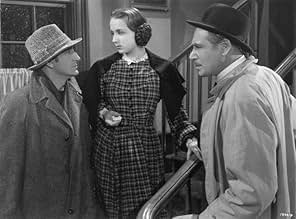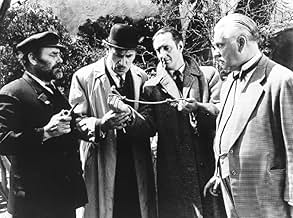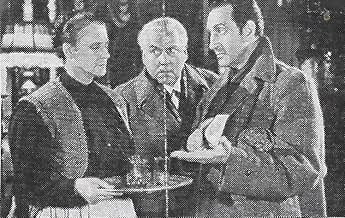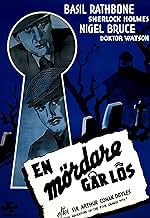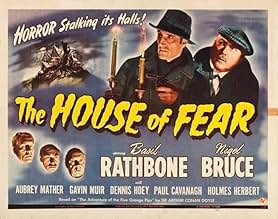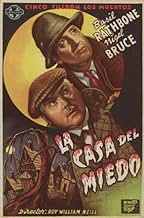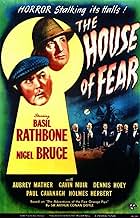NOTE IMDb
7,2/10
5,9 k
MA NOTE
Ajouter une intrigue dans votre langueSherlock Holmes investigates a series of deaths at a castle with each foretold by the delivery of orange pips to the victims.Sherlock Holmes investigates a series of deaths at a castle with each foretold by the delivery of orange pips to the victims.Sherlock Holmes investigates a series of deaths at a castle with each foretold by the delivery of orange pips to the victims.
- Réalisation
- Scénario
- Casting principal
Richard Alexander
- Ralph King
- (non crédité)
C.E. Anderson
- Mourner
- (non crédité)
Wilson Benge
- Guy Davies
- (non crédité)
Hobart Cavanaugh
- Bit Part
- (non crédité)
Alec Craig
- Angus
- (non crédité)
Cyril Delevanti
- Stanley Raeburn
- (non crédité)
Leslie Denison
- Sergeant Bleeker
- (non crédité)
Avis à la une
With lots of atmospheric detail and an interesting, involved Sherlock Holmes mystery story, this is one of many enjoyable features in the Basil Rathbone/Nigel Bruce series. The plot is, to be honest, pretty far-fetched, but it makes for a very entertaining story with lots of intriguing developments. The supporting cast features Dennis Hoey as Inspector Lestrade, Aubrey Mather as an interesting oddball character, and Paul Cavanagh in a good role as one of the suspects.
The story takes some of the basic elements from Arthur Conan Doyle's "The Five Orange Pips", but places it in an entirely new setting that works much better on the screen. It also adds many other ideas, some from Doyle, and some from other sources. The good cast and the effective atmosphere in a remote corner of Scotland help to keep the story interesting instead of straining plausibility.
Roy William Neill does one of his many solid directing jobs in the series, keeping a good balance between entertainment and mystery, and between the original characters and the contemporary setting. It might not be the most tightly-crafted of the series, but it's certainly one of the more enjoyable ones to watch.
The story takes some of the basic elements from Arthur Conan Doyle's "The Five Orange Pips", but places it in an entirely new setting that works much better on the screen. It also adds many other ideas, some from Doyle, and some from other sources. The good cast and the effective atmosphere in a remote corner of Scotland help to keep the story interesting instead of straining plausibility.
Roy William Neill does one of his many solid directing jobs in the series, keeping a good balance between entertainment and mystery, and between the original characters and the contemporary setting. It might not be the most tightly-crafted of the series, but it's certainly one of the more enjoyable ones to watch.
Sherlock Holmes and his mumbling sidekick Dr. Watson go to Scotland to investigate the deaths of members of "The Good Comrades," a group of seven lonely men that make a pact to split the money of each dying member. A maid has been given a letter to give the members of the group at dinner. The letter contains a number of orange pips(pits) that coincides with the remaining number of the group. After receiving the letter, the member shortly dies after. This is highly enjoyable fare from the Sherlock Holmes team of Rathbone, Bruce, Dennis Hoey as Lestrade, and director Roy William Neill. The film zips by at a nice pace, and it has a unique mystery which I could only partially unravel. Rathbone is at his best, but Bruce tends to steal almost every scene he is in with his mumbling antics and comedic abilities. The rest of the cast of stalwart British character actors do just as ably with Aubrey Mather really standing out as the genial owner of the home where the Good Comrades stay. Lots of dark atmosphere, rainy nights, and Scottish lore to surround this intriguing tale.
Above average Holmes. The real stars, however, are the evocative Gothic interiors of the seaside cliff house. The dimly-lit great halls and chambers provide genuine atmosphere, and are a tribute to Universal's art and set directors, respectively. The plot itself is reasonably compelling as we try to guess who's killing off members of a gentleman's club one-by-one. Still and all, the brief running time, 69 minutes, doesn't allow much character development, so the whodunit angle remains underdeveloped. Couple that with the pointless presence of an unfunny Inspector LaStrade (isn't Watson supposed to supply the comic relief?) and much valuable screen time is wasted. I wish the screenplay had taken better advantage of the spooky sets by playing up the menace, as for example, the shadowy appearance of the mystery man's shoes. Or Sally Shepherd as the zombie-like housekeeper, Mrs. Monteith, who's enough to make you want to clean your own castle. Nonetheless, there's enough mystery, atmosphere, and Basil Rathbone to make this a solid Holmes entry.
While it's not as great as earlier Holmes mysteries, such as The Hound of the Baskervilles, The Adventures of Sherlock Holmes and The Scarlet Claw; The House of Fear is still an admirable entry in Holmes' list of triumphs. My favourite detective mysteries are always the ones that include a dash of horror, and I'm pleased to remark that this one has that. The film is directed by Roy William Neill; the same man that directed fellow horror-orientated Holmes yarn, The Scarlet Claw. For this film, Neill has succeeded in capturing a foreboding and intriguing atmosphere once again, and the story, which includes a rickety old house, benefits immensely from that. The story follows a group of men that have moved to Scotland from London after forming a club and buying a large house. After two of them are murdered subsequent to receiving strange notes, the super-sleuth and his trusty sidekick; Dr Watson are called in to get to the bottom of the mystery. Could the fact that each member of the group is a beneficiary of each of the others' life insurance policies have anything to do with it?
This film is very short at just 69 minutes, and this is part of the reason why the film doesn't work quite as well as other Holmes yarns. Despite being short, the film doesn't have many moments of real tension and there are several instances where the story slows down to walking pace, and these can be a trifle dull. The story in this movie is rather thin, but, despite it's lack of tension, it does have intrigue; which redeems the plotting somewhat. One thing that the film definitely does benefit from is that, like all other Universal Holmes films made in the 30's and 40's, it stars the great Basil Rathbone as the great detective and Nigel Bruce as the sidekick; Dr Watson. These two have a great on-screen chemistry, and you can really believe that they are old friends. The climax of the film is nice and it's unlikely that you'll see it coming...but that's its main vice also; it's somewhat unlikely. I'm becoming a big fan of Sherlock Holmes movies, so I'm rating this one a little higher than many would; but in spite of my slight bias, this is still a very good film and one that Holmes fans will not want to miss
This film is very short at just 69 minutes, and this is part of the reason why the film doesn't work quite as well as other Holmes yarns. Despite being short, the film doesn't have many moments of real tension and there are several instances where the story slows down to walking pace, and these can be a trifle dull. The story in this movie is rather thin, but, despite it's lack of tension, it does have intrigue; which redeems the plotting somewhat. One thing that the film definitely does benefit from is that, like all other Universal Holmes films made in the 30's and 40's, it stars the great Basil Rathbone as the great detective and Nigel Bruce as the sidekick; Dr Watson. These two have a great on-screen chemistry, and you can really believe that they are old friends. The climax of the film is nice and it's unlikely that you'll see it coming...but that's its main vice also; it's somewhat unlikely. I'm becoming a big fan of Sherlock Holmes movies, so I'm rating this one a little higher than many would; but in spite of my slight bias, this is still a very good film and one that Holmes fans will not want to miss
I'd have to rate this as one of the best of the Basil Rathbone Sherlock Holmes films. It has about everything you would want in these movies - suspense, action, a clever story and some good humor courtesy our friend Dr. Watson. The latter is in top form with a number of funny lines and reactions to the happenings around him.
Meanwhile, this plays like the Agatha Christie story, "And Then There Were None." Instead of "10 Little Indians," there are the "orange pips" which are sent in an envelope to the members of the "The Good Comrades" club up in Drearcliff, Scotland. Whoever receives the envelope is shortly thereafter murdered in a grisly way. Holmes, Watson and then Inspector Lestrade of Scotland Yard, all venture up to the Scottish mansion to investigate the murders.
This is good stuff with nary a lull during the 69-minute film that features a variety of suspects, from evil-looking to the nicest guy in the house. Who is committing these murders is anyone's guess, right down to the end.
Meanwhile, this plays like the Agatha Christie story, "And Then There Were None." Instead of "10 Little Indians," there are the "orange pips" which are sent in an envelope to the members of the "The Good Comrades" club up in Drearcliff, Scotland. Whoever receives the envelope is shortly thereafter murdered in a grisly way. Holmes, Watson and then Inspector Lestrade of Scotland Yard, all venture up to the Scottish mansion to investigate the murders.
This is good stuff with nary a lull during the 69-minute film that features a variety of suspects, from evil-looking to the nicest guy in the house. Who is committing these murders is anyone's guess, right down to the end.
Le saviez-vous
- AnecdotesThe shot of the "grim old house perched high upon a cliff on the west coast of Scotland" was also used in Sherlock Holmes et la voix de la terreur (1942). The house in the shot could not possibly be the Alastair home because, firstly, it is a church and not a house, and, secondly, close inspection reveals that the front of the house is in ruins.
- GaffesAs the murders took place in Scotland, a local policeman would have been sent to the crime scene, not Inspector Lestrade from London. The local constabulary contacted Scotland Yard/Inspector Lestrade at the behest of Sherlock Holmes. It is unlikely a policeman would have been sent from London to the north of Scotland during wartime, even at the request of Sherlock Holmes.
- Citations
Sherlock Holmes: Murder is an insidious thing, Watson. Once a man has dipped his fingers in blood, sooner or later he'll feel the urge to kill again.
- ConnexionsEdited into Who Dunit Theater: Sherlock Holmes and the House of Fear (2021)
Meilleurs choix
Connectez-vous pour évaluer et suivre la liste de favoris afin de recevoir des recommandations personnalisées
- How long is The House of Fear?Alimenté par Alexa
- Chicago Opening Happened When?
Détails
- Date de sortie
- Pays d’origine
- Langue
- Aussi connu sous le nom de
- Sherlock Holmes et la maison de la peur
- Lieux de tournage
- Société de production
- Voir plus de crédits d'entreprise sur IMDbPro
- Durée1 heure 9 minutes
- Couleur
- Rapport de forme
- 1.37 : 1
Contribuer à cette page
Suggérer une modification ou ajouter du contenu manquant

Lacune principale
By what name was La maison de la peur (1945) officially released in Canada in English?
Répondre
